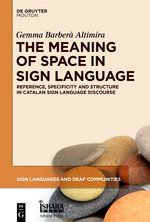The meaning of space in Sign Language: reference, specificity and structure in Catalan Sign Language Discourse
Temas
Detalles
Bringing together sign language linguistics and the semantics-pragmatics interface, this book focuses on the use of signing space in Catalan Sign Language (LSC). On the basis of small-scale corpus data, it provides an exhaustive description of referential devices dependent on space. The book provides insight into the study of meaning in the visual-spatial modality and into our understanding of the discourse behavior of spatial locations.
This thesis concerns the use of sign space in Catalan Sign Language (LSC) at the discourse level. I argue that non-descriptive locations are established in the three spatial planes and I describe the grammatical features contained within them. Spatial locations are morphophonologically marked with an abstract point in space which does not have a specific direction and which is categorically interpreted in the linguistic system. In LSC, the frontal plane is grammatically relevant for specificity marking: lower spatial locations correlate with specificity, whereas upper locations correlate with non-specificity. Moreover, the incorporation of discourse structure into the analysis shows that the establishment of lower spatial locations also denotes discourse prominence. Hence, spatial locations are integrated into the grammar of LSC and they are analysed here with respect to the role they play in the denotation of specificity and discourse structure. The analysis is framed under the formalisation of Discourse Representation Theory, on the basis of a small-scale LSC corpus.





